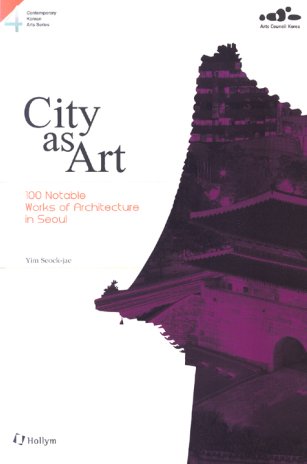
By Yim Seok-jae
(Hollym)
From Gyeongbokgung to the old Seoul Station, it’s easy to spot historically significant buildings in Seoul. The city boasts a long history dating back to the Three Kingdoms period (B.C. 57-A.D. 688) and served as the national capital of the Joseon Dynasty (1392-1897) for some 600 years. And as a result of rapid modernization and economic development in the last 60 years, Seoul also houses skyscrapers as well as other modern buildings.
Scholar Yim Seok-jae’s English-language book, “City as Art ― 100 Notable Works of Architecture in Seoul” introduces 100 architectural works that are significant to Korea’s history and culture. The book is divided into six chapters according to different time periods: Traditional Architecture: 15th- Late 19th Century; Early Modern and Colonial Architecture; Late 19th Century-1945; Modern Architecture Part 1 and 2 (1950-1980s); Contemporary Architecture: 1990-Pressent; and Architecture by International Masters.
In chapter one, Yim explores how Joseon’s architecture sought balance in nature in its design and craftsmanship, by giving examples of many monumental buildings including Gyeonggokgung, Jongmyo shrine and Jogyesa.
According to Yim, Korea’s architecture began to adapt Western style in the late 19th century. The second chapter features the architecture built from the late 19th century to 1945, including the famous Myeongdong Cathedral, the old Seoul Station, as well as Pfeiffer Hall of Ewha Womans University.
In chapters three and four, Yim delves into how buildings in Korea embraced Western style even more from 1950 to 1980, heavily influenced by modernization and economic development. Featured buildings in these two chapters include the Sejong Center, Seoul Arts Center, National Museum of Korea, as well as LG Samgam Library.
Starting in the 1990s, however, Korea’s architecture tried to “break away” from industrialization by trying to “blend in with the environment,” according to Yim. He introduces such “environmentally conscious” buildings and sites in chapter five, including Seonyudo Park, Insa-dong’s Ssamziegil building, Seoul World Cup Stadium and Total Museum of Contemporary Art.
The last chapter features some of the most famous buildings in Seoul which have been designed by world famous architects. Featured buildings include Ewha Womans University’s Ewha Campus Center which was designed by Paris-based architect Dominique Perrault, and Museum of Art, Seoul National University by renowned Dutch architect Rem Koolhaas.
Professor Yim Seok-jae graduated from Seoul National University’s architecture program, and received his master’s degree from University of Michigan, and his Ph.D. from University of Pennsylvania. He currently teaches at the architecture department of Ewha Womans University.
The book is one of the four English-language volumes of “Contemporary Korean Arts Series,” which was published by the Arts Council Korea last year.
(dyc@heraldcorp.com)




![[Music in drama] Rekindle a love that slipped through your fingers](http://res.heraldm.com/phpwas/restmb_idxmake.php?idx=644&simg=/content/image/2024/05/01/20240501050484_0.jpg&u=20240501151646)

![[New faces of Assembly] Architect behind ‘audacious initiative’ believes in denuclearized North Korea](http://res.heraldm.com/phpwas/restmb_idxmake.php?idx=644&simg=/content/image/2024/05/01/20240501050627_0.jpg&u=20240502093000)



![[KH Explains] Will alternative trading platform shake up Korean stock market?](http://res.heraldm.com/phpwas/restmb_idxmake.php?idx=644&simg=/content/image/2024/05/01/20240501050557_0.jpg&u=20240501161906)







![[Today’s K-pop] Stray Kids go gold in US with ‘Maniac’](http://res.heraldm.com/phpwas/restmb_idxmake.php?idx=642&simg=/content/image/2024/05/02/20240502050771_0.jpg&u=)